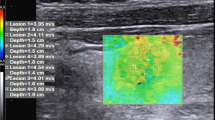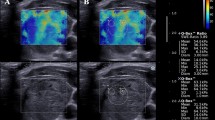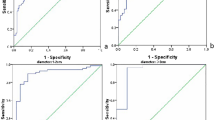Abstract
Objectives
To evaluate the diagnostic performance of two-dimensional shear wave elastography (2D-SWE) in distinguishing malignant from benign thyroid nodules.
Methods
A total of 331 focal thyroid nodules from 271 patients scheduled for fine-needle aspiration or thyroid surgery were included. After a routine conventional ultrasound evaluation, 2D-SWE examinations were performed to obtain 2D-SWE measurements on a colour-coded mapping, which were then correlated with pathology results.
Results
A total of 230 nodules were benign and 101 were malignant on pathology. The areas under the receiver operating characteristic curve (AUC) of mean and minimum values in the largest region of interest (ROI) over the whole nodule, and mean, maximum and minimum values in 2-mm ROI over the stiffest area of the nodule were 0.794, 0.673, 0.808, 0.805 and 0.799, respectively. The most accurate cut-off value, 39.3 kPa, for mean value in a 2-mm ROI achieved 66.3 % sensitivity and 84.4 % specificity to discriminate malignancy. Nodule size correlated with 2D-SWE value for malignant nodules (P < 0.01). In the group of nodules ≤10 mm, the AUC was 0.730, while it was 0.883 in nodules sized 11–30 mm and 0.821 in nodules >30 mm.
Conclusion
2D-SWE is a promising diagnostic tool for discriminating malignant thyroid nodules, although the performance for nodules ≤10 mm is not satisfactory.
Key Points
• 2D-shear wave elastography (2D-SWE) helps differentiate benign nodules from malignancy.
• Calcification will increase the 2D-SWE value.
• 2D-SWE appears limited in terms of identifying papillary thyroid microcarcinomas accurately.
• Combination of 2D-SWE and conventional ultrasound is highly sensitivity for thyroid malignancy.





Similar content being viewed by others
Abbreviations
- 2D-SWE:
-
Two-dimensional shear wave elastography
- AUC:
-
Areas under the ROC curve
- FNA:
-
Fine-needle aspiration
- NPV:
-
Negative predictive value
- PPV:
-
Positive predictive value
- ROC:
-
Receiver operating characteristic
- ROI:
-
Region of interest
- SWE_max:
-
Maximum SWE value in the 2-mm ROI
- SWE_mean:
-
Mean SWE value in the 2-mm ROI
- SWE_min:
-
Minimum SWE value in the 2-mm ROI
- SWE_whole_mean:
-
Mean SWE value in the largest ROI
- SWE_whole_min:
-
Minimum SWE value in the largest ROI
- SWE_ratio:
-
Ratio between SWE_mean and the elastic value of the surrounding thyroid tissue
- US:
-
Ultrasound
References
Sebag F, Vaillant-Lombard J, Berbis J et al (2010) Shear wave elastography: a new ultrasound imaging mode for the differential diagnosis of benign and malignant thyroid nodules. J Clin Endocrinol Metab 95:5281–5288
Magri F, Chytiris S, Capelli V et al (2012) Shear wave elastography in the diagnosis of thyroid nodules: feasibility in the case of coexistent chronic autoimmune Hashimoto’s thyroiditis. Clin Endocrinol (Oxf) 76:137–141
Hegedus L (2004) Clinical practice. The thyroid nodule. N Engl J Med 351:1764–1771
Remontet L, Esteve J, Bouvier AM et al (2003) Cancer incidence and mortality in France over the period 1978-2000. Rev Epidemiol Sante Publique 51:3–30
Zhang B, Jiang YX, Liu JB et al (2010) Utility of contrast-enhanced ultrasound for evaluation of thyroid nodules. Thyroid 20:51–57
Bhatia KS, Tong CS, Cho CC, Yuen EH, Lee YY, Ahuja AT (2012) Shear wave elastography of thyroid nodules in routine clinical practice: preliminary observations and utility for detecting malignancy. Eur Radiol 22:2397–2406
Kim H, Kim JA, Son EJ, Youk JH (2013) Quantitative assessment of shear-wave ultrasound elastography in thyroid nodules: diagnostic performance for predicting malignancy. Eur Radiol 23:2532–2537
Veyrieres JB, Albarel F, Lombard JV et al (2012) A threshold value in shear wave elastography to rule out malignant thyroid nodules: a reality? Eur J Radiol 81:3965–3972
Shuzhen C (2012) Comparison analysis between conventional ultrasonography and ultrasound elastography of thyroid nodules. Eur J Radiol 81:1806–1811
Zhang YF, Xu HX, He Y et al (2012) Virtual touch tissue quantification of acoustic radiation force impulse: a new ultrasound elastic imaging in the diagnosis of thyroid nodules. PLoS One 7:e49094
Liu BX, Xie XY, Liang JY et al (2014) Shear wave elastography versus real-time elastography on evaluation thyroid nodules: a preliminary study. Eur J Radiol 83:1135–1143
Evans A, Whelehan P, Thomson K et al (2012) Invasive breast cancer: relationship between shear-wave elastographic findings and histologic prognostic factors. Radiology 263:673–677
Ferraioli G, Tinelli C, Dal Bello B, Zicchetti M, Filice G, Filice C (2012) Accuracy of real-time shear wave elastography for assessing liver fibrosis in chronic hepatitis C: a pilot study. Hepatology 56:2125–2133
Foucher J, Chanteloup E, Vergniol J et al (2006) Diagnosis of cirrhosis by transient elastography (FibroScan): a prospective study. Gut 55:403–408
Kwon HJ, Kang MJ, Cho JH et al (2011) Acoustic radiation force impulse elastography for hepatocellular carcinoma-associated radiofrequency ablation. World J Gastroenterol 17:1874–1878
Garra BS (2011) Elastography: current status, future prospects, and making it work for you. Ultrasound Q 27:177–186
Lee SH, Chang JM, Kim WH et al (2013) Differentiation of benign from malignant solid breast masses: comparison of two-dimensional and three-dimensional shear-wave elastography. Eur Radiol 23:1015–1026
Tae HJ, Lim DJ, Baek KH et al (2007) Diagnostic value of ultrasonography to distinguish between benign and malignant lesions in the management of thyroid nodules. Thyroid 17:461–466
Wang Y, Dan HJ, Dan HY, Li T, Hu B (2010) Differential diagnosis of small single solid thyroid nodules using real-time ultrasound elastography. J Int Med Res 38:466–472
Tozaki M, Fukuma E (2011) Pattern classification of ShearWave elastography images for differential diagnosis between benign and malignant solid breast masses. Acta Radiol 52:1069–1075
Lee EJ, Jung HK, Ko KH, Lee JT, Yoon JH (2013) Diagnostic performances of shear wave elastography: which parameter to use in differential diagnosis of solid breast masses? Eur Radiol 23:1803–1811
Lagalla R, Caruso G, Romano M, Midiri M, Novara V, Zappasodi F (1993) Echo-color Doppler in thyroid disease. Radiol Med 85:109–113
Messina G, Viceconti N, Trinti B (1996) Echotomography and color-Doppler in the diagnosis of thyroid carcinoma. Ann Ital Med Int 11:263–267
Soares P, Celestino R, Gaspar DRA, Sobrinho-Simoes M (2014) Papillary thyroid microcarcinoma: how to diagnose it and how to manage this epidemics? Int J Surg Pathol 22:113–119
Acknowledgments
The scientific guarantor of this publication is Xiaoyan Xie. The authors of this manuscript declare no relationships with any companies whose products or services may be related to the subject matter of the article. The authors state that this work has not received any funding. No complex statistical methods were necessary for this paper. Institutional review board approval was obtained. Written informed consent was obtained from all subjects (patients) in this study. Methodology: prospective, diagnostic or prognostic study, performed at one institution.
Author information
Authors and Affiliations
Corresponding author
Rights and permissions
About this article
Cite this article
Liu, B., Liang, J., Zheng, Y. et al. Two-dimensional shear wave elastography as promising diagnostic tool for predicting malignant thyroid nodules: a prospective single-centre experience. Eur Radiol 25, 624–634 (2015). https://doi.org/10.1007/s00330-014-3455-8
Received:
Revised:
Accepted:
Published:
Issue Date:
DOI: https://doi.org/10.1007/s00330-014-3455-8




